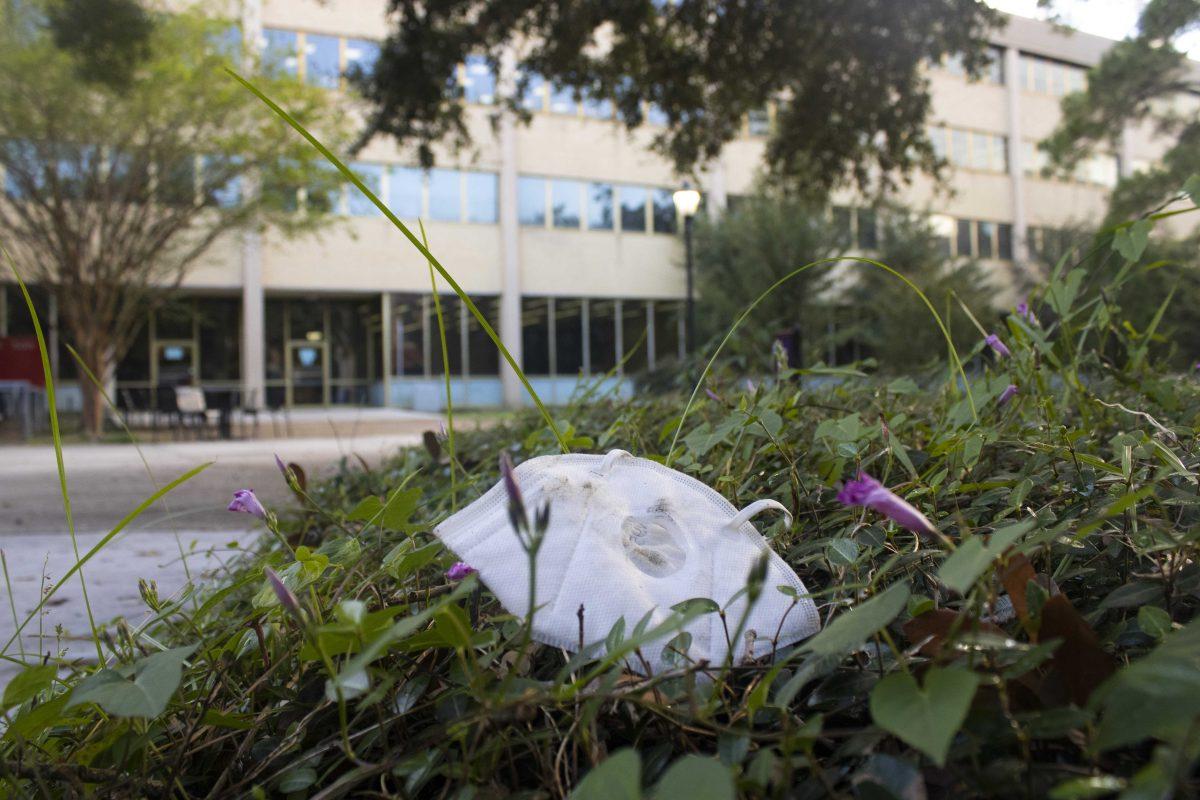Despite the convenience and affordability of disposable masks, experts express concerns with the waste they produce from improper disposal.
If left under the sun, the common blue disposable masks, made of polypropylene plastic fibers, begin to break down due to exposure to ultraviolet light, becoming brittle and eventually breaking down into microplastics, said Mark Benfield, professor of oceanography and coastal studies.
“Ultimately, a single mask can produce millions of microplastic fibers,” Benfield, who specializes in plastic pollution, said.
If these tiny fibers enter water supplies, they begin to attract organic molecules like herbicides, pesticides and other harmful chemicals. These microplastics become “an Uber for all these toxic chemicals,” Benfield said.
The organic fibers that become incorporated into water supplies, including marine ecosystems, are eventually colonized by microbes. These microbes produce a taste and smell attractive to organisms at the bottom of the food chain. This, paired with their similar size and shapes to their natural food, introduces these microplastics into small fish.
The toxic effects eventually make their way up the food chain, Benfield explained, through a process called biomagnification.
Some other results of improperly disposed masks are more long term, like decreased growth rates among marine organisms and an “eyesore” that will last years as masks decompose.
“They’ll be around when our freshmen are grandparents,” Benfield said. “We’re talking about very long periods of time.”
Wayne Newhauser, professor and director of medical and health physics, warns that how one removes and disposes of a face mask can affect the spread of Covid-19.
“[The virus] can be transmitted by inhalation and surface contact. For example if you’re infected, you touch your mask, then touch a doorknob and someone else touches the doorknob, touches their eyes or their mouth, infection can occur that way,” Newhauser said. “A mask that is no longer in use is a contact pathway.”
He said that in order to ensure that a mask doesn’t become a contact hazard after use, make sure it’s disposed of in a “decent trash container.”
“We should not litter [masks]. Eventually someone’s going to have to pick these up and risk infection,” Newhauser said. “In most settings, throwing them in a trash can is probably fine. But if someone is infected or may be infected, it’s probably not a good idea to dispose of masks [this way].”
One solution is to recycle the masks in the blue cans around campus.
“There’s a huge number of these disposable masks that get thrown out. And they’re energy-intensive products, meaning there’s a lot of energy and materials going into them,” Newhauser said. “[This energy and material] can be recovered and turned into a biofuel, at least N-95 masks can be.”
Organizations like ReWorked and TerraCycle provide PPE recycling to universities and other institutions that safely dispose of and repurpose masks into new materials for furniture and retail, according to ReWorked’s website.
The university has already begun looking at ways to recycle masks that coincides with Benfield’s advice to “make a plan to wear and discard masks responsibly.”
“The university has PPE recycling boxes in various locations on campus to collect the disposable masks,” LSU spokesman Ernie Ballard said.
The boxes, provided by TerraCycle, are located in the Student Union, the LSU Library, the UREC and the BEC lobby.
Benfield hopes that the university’s recycling efforts and other precautions taken to dispose of masks properly will help create thoughtful conversations about environmental health.
“There’s definitely a need for education that the word disposable doesn’t mean it can be disposed of anywhere. You should take the same precautions with this mask that you do with a plastic water bottle,” Benfield said. “Every one of these masks on the ground is really just one rainfall away from starting its journey to the ocean.”







